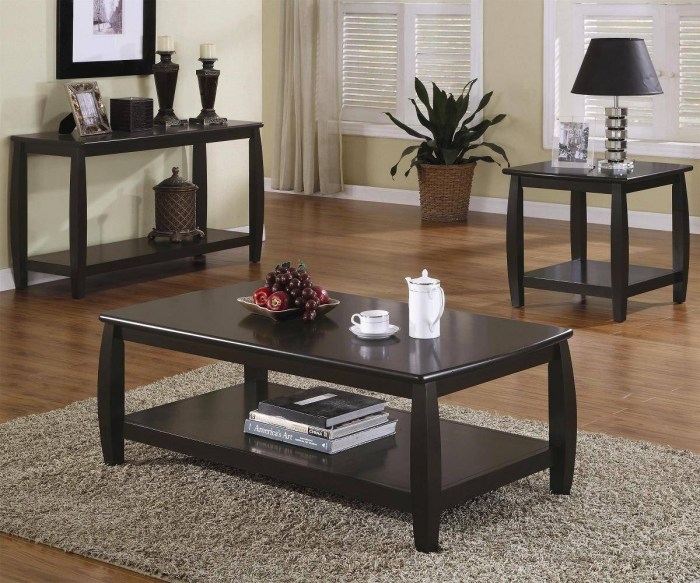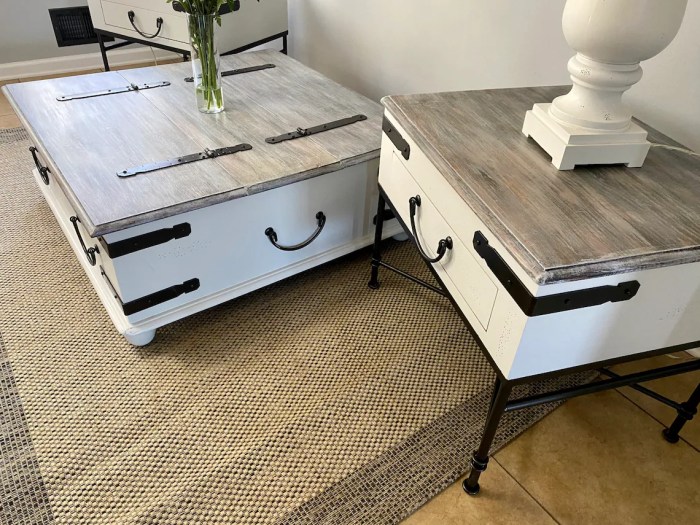Matching end table furniture for sofas transforms a living space. Finding the perfect complement to your sofa elevates the room’s aesthetic, creating a cohesive and stylish look. The right end tables offer practical functionality, providing surfaces for lamps, drinks, and decorative items, while simultaneously enhancing the overall design. This guide explores various styles, materials, and considerations to help you make an informed choice.
From sleek modern designs to classic traditional pieces, the options are vast. Understanding your sofa’s style, the room’s existing décor, and your personal preferences are crucial steps in selecting the ideal end tables. We’ll delve into different materials, sizes, and functionalities to ensure you find the perfect match for both style and practicality.
Choosing the right end tables can significantly elevate the aesthetic appeal and functionality of your living room. These seemingly small pieces of furniture play a crucial role in creating a balanced and inviting space. This comprehensive guide will delve into the key considerations for selecting end tables that perfectly complement your sofa, ensuring a cohesive and stylish living room design.
Understanding Your Sofa: The Foundation of Your Selection
Before embarking on your end table hunt, it’s essential to thoroughly assess your existing sofa. Several key factors will influence your choice:
Sofa Style:
* Traditional: A classic sofa often pairs well with equally traditional end tables, perhaps featuring ornate details, wood carvings, or a rich, dark finish. Materials like mahogany or cherry wood would be appropriate choices.
Modern/Contemporary
Clean lines and minimalist designs are key here. Look for end tables with sleek silhouettes, potentially made from materials like glass, metal, or lacquered wood.
Mid-Century Modern
This style blends clean lines with organic shapes. Consider end tables with tapered legs, rounded edges, and materials like teak or walnut.

Transitional
This style bridges the gap between traditional and modern. You have more flexibility here, allowing for a blend of styles and materials.
Sofa Size and Scale:
* Large Sofa: A large sofa demands substantial end tables to maintain visual balance. Overly small end tables will appear dwarfed and disproportionate.
Small Sofa
Avoid overly large end tables that will overwhelm a smaller sofa. Choose pieces that are appropriately scaled to maintain harmony.
Sectional Sofa
Consider the overall dimensions of your sectional and select end tables accordingly. You may need multiple end tables or a combination of end tables and ottomans to create a balanced arrangement.
Sofa Color and Material:
* Color Coordination: Consider the color of your sofa fabric or upholstery. You can opt for matching colors for a cohesive look or choose complementary colors for a more dynamic effect.
Material Harmony
The materials of your sofa and end tables should complement each other. For example, a leather sofa might pair well with a metal or wood end table, while a fabric sofa might look great with a wooden or upholstered end table.
Essential Considerations for End Table Selection: Matching End Table Furniture For Sofas
Beyond the sofa itself, several other factors influence your choice:
Height and Width:
* Armrest Height: The ideal end table height should be roughly the same height as your sofa’s armrest. This creates a comfortable and visually appealing arrangement.
Tabletop Space
Ensure the tabletop offers sufficient space for drinks, remotes, books, or other items you might want within easy reach.
Width Proportion
The width of the end table should be proportionate to the sofa’s width. Avoid tables that are too wide or too narrow.
Material and Finish:
* Wood: Wood end tables offer a classic and versatile option. Different wood types offer various aesthetics and durability levels.
Metal
Metal end tables can add a modern or industrial touch. They’re often durable and easy to clean.
Glass
Glass end tables offer a sleek and contemporary look, but they can be more prone to scratches and fingerprints.
Stone
Stone end tables can add a touch of luxury and sophistication, but they can be heavier and more expensive.
Upholstered
Upholstered end tables offer a soft and comfortable option, especially if you want to add a textural element.
Storage and Functionality:
* Drawers and Shelves: Consider end tables with drawers or shelves for added storage. This is especially useful for smaller living rooms.
Open Shelving
Open shelving provides easy access to items but may not offer as much storage as drawers.
Multi-functional Designs
Some end tables incorporate features like built-in lighting or charging ports.
Style and Aesthetics:, Matching end table furniture for sofas
* Overall Design Theme: Choose end tables that complement the overall design theme of your living room.
Personal Preferences

Ultimately, the best end tables are those that you find aesthetically pleasing and functional.
Popular End Table Styles and Materials
* Wood End Tables: From rustic farmhouse styles to sleek modern designs, wood end tables offer endless possibilities. Consider materials like oak, walnut, mahogany, or cherry.
Metal End Tables
Metal end tables, often crafted from steel, iron, or aluminum, can add an industrial or contemporary feel.
Glass End Tables
Glass end tables provide a modern and minimalist look. They can be combined with metal or wood bases for added visual interest.
Stone End Tables
Marble, granite, and other stone materials can elevate the sophistication of your living room. They’re durable but can be heavy.
Rattan and Wicker End Tables
These materials add a touch of natural texture and warmth, particularly suitable for bohemian or coastal styles.
Frequently Asked Questions (FAQ)
* Q: How far apart should end tables be placed from the sofa?
A
A general guideline is to leave about 18-24 inches of space between the sofa and the end tables. This allows for comfortable seating and easy access to the tables.* Q: Should my end tables match exactly?
A
Not necessarily. While matching end tables can create a symmetrical and balanced look, you can also use different but complementary end tables for a more eclectic feel.* Q: What size end table is right for my sofa?
A
The ideal size depends on the size of your sofa. A general rule of thumb is to choose end tables that are about 1/2 to 2/3 the length of your sofa.* Q: How do I choose end tables for a sectional sofa?
A
For a sectional, you might need multiple end tables, or a combination of end tables and ottomans, depending on the size and shape of the sectional.* Q: What are some budget-friendly options for end tables?
A
Consider checking out online marketplaces, furniture stores with sales, or exploring DIY options.

Finding Your Perfect Match: A Final Word
Selecting the right end tables is a crucial step in creating a comfortable and stylish living room. By carefully considering your sofa’s style, size, and color, as well as your personal preferences and functional needs, you can find the perfect end tables to complement your space. Remember to prioritize functionality and aesthetics to achieve a truly harmonious living room design.
Call to Action
Ready to transform your living room? Start browsing our curated selection of end tables today and find the perfect match for your sofa! [Link to relevant product page]
FAQ Insights
What materials are best for end tables?
Popular choices include wood (various types offer different aesthetics), metal (for a modern feel), and glass (for a contemporary look). Consider durability and your existing décor when choosing.
How do I determine the right size end tables?
End tables should be proportionate to your sofa. Generally, they should be slightly lower than the sofa’s armrests and not overwhelm the seating area.
Should my end tables match my sofa exactly?
Exact matching isn’t necessary. Complementary styles and colors work well. Consider coordinating materials or colors to create a cohesive look.
